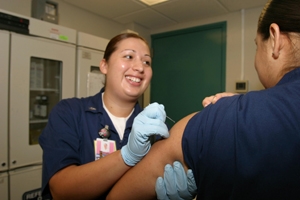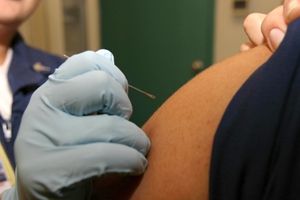Marine Headline News
Okinawa-based
Marines push to meet smallpox vaccination goal
by Sgt Matt Scotten, Distribution Specialist
Okinawa Marine Newspaper
CAMP
FOSTER — Units islandwide are pushing to meet the May 1 goal
for smallpox vaccinations for the more than 20,000
servicemembers currently assigned to the III Marine
Expeditionary Force.
Medical personnel must screen and vaccinate
all medically qualified servicemembers in order to meet the
goal outlined in a letter of instruction issued by the III MEF
commanding general, Lt. Gen. Robert R. Blackman, this past
February.
The LOI was in response to a message sent by
Secretary of Defense Donald H. Rumsfeld to hospitals
militarywide Sept. 2, directing the expansion of the smallpox
vaccination program to deploying servicemembers.
The immunization program was expanded as part
of an ongoing military inoculation plan that began in 2002, in
order to give military members an additional layer of
protection, in addition to antibiotics, against infectious
diseases.
Smallpox was officially considered eradicated
in 1977, but the United States and the former Soviet Union
kept samples of the disease for research purposes, explained
Lt. Cmdr. Reed Pate, an occupational medicine physician at the
U.S. Naval Hospital Okinawa in a smallpox briefing here March
8. In 1980, the former Soviet Union lost its samples of the
virus, and it is unknown whether the samples were given to
other countries in an effort to create biological weapons.
Servicemembers need to receive the smallpox
vaccine before deploying to areas such as Korea and Iraq,
which are high-risk areas for biological weapons, Pate
stressed.
Before a servicemember receives the
vaccination, he must receive a brief that outlines how the
vaccination works, vaccination site care and medical problems
that may prevent a servicemember from receiving the shot.
Representatives from the USNH have been giving
mass briefings to Marines islandwide in order to meet the May
1 goal.
Following the brief, all individuals who
are eligible to receive the vaccine will undergo a one-on-one
medical screening with a specifically trained healthcare
provider to ensure that the servicemember does not have any
medical conditions that would make it dangerous for them to
receive the vaccine.
People who would not receive the smallpox
vaccine are those who have weakened immune systems, including
people with AIDS, HIV, cancer, recent organ transplants or who
are currently ill, Pate explained. Additionally, people with
certain skin problems and women who are pregnant are not
eligible for the vaccine.
The USNH has also been administering the
vaccine to individual units and servicemembers at their place
of work.
“Instead of making all the Marines come to
(the hospital), we have been going to them,” Pate said.
The prevalent symptoms of smallpox are fever,
chills and a rash, which is mostly concentrated on the face,
legs and arms. The rash consists of swollen lumps under the
skin and leaves individuals with permanent, disfiguring scars.
About 30 percent of people who become infected with smallpox
will die from the virus if not previously vaccinated,
according to the military’s vaccines Web site at http://www.vaccines.mil.
The smallpox vaccine is administered with a
small pitchfork-like needle, which is dipped into the vaccine
and jabbed into the skin three times, usually on the upper
arm, and it protects about 95 percent of people exposed to the
virus, Pate explained.
A small blister forms at the vaccination site
within six to eight days if the vaccine is working correctly.
The virus stays at the site of the blister, making it
extremely important for people not to touch the site after the
inoculation. If a person touches the blister or scab, the
virus could spread to other parts of the body, which could
create a similar blister, Pate stressed.
The blister will turn into a scab, after the
body has fought the virus, and fall off in about 21 days.
About 20 percent of those vaccinated suffer
from side effects of the vaccine, which may include a
headache, sore arm, itching at the site of the inoculation or
fatigue, according to Pate.
“Since (the hospital) usually deals with
young, healthy servicemembers, most everyone is eligible for
the vaccine,” Pate said.
Servicemembers required to receive the
smallpox vaccine will be contacted by their respective
unit’s vaccine coordinators with scheduled appointments.

CAMP LESTER, OKINAWA, Japan – After
receiving a smallpox vaccine, patients will develop a blister
at the vaccination site, if the vaccine is working correctly.
The blister will eventually turn into a scab, after the body
has fought the virus, and then fall off. (Official U.S. Marine
Corps photo by Lance Cpl. Cathryn D. Lindsay)

CAMP LESTER, OKINAWA, Japan -- A smallpox
vaccination is given at the U.S. Naval Hospital Okinawa Sept.
24. Servicemembers are receiving smallpox inoculations as
outlined in a letter of instruction issued by the commanding
general of the III Marine Expeditionary Force, Lt. Gen. Robert
R. Blackman, this past February. The LOI was in response to a
message sent by Secretary of Defense Donald H. Rumsfeld to
hospitals militarywide Sept. 2, directing the expansion
of the smallpox vaccination program to deploying
servicemembers. (Official U.S. Marine Corps photo by Lance
Cpl. Cathryn D. Lindsay)

CAMP LESTER, OKINAWA, Japan -- Petty Officer
3rd Class Trista N. James gives Seaman Ester O. Alvarez a
smallpox vaccination at the U.S. Naval Hospital Okinawa Sept.
24. Servicemembers need to receive a smallpox vaccine before
deploying to areas considered high-risk for biological weapon
attacks. The Secretary of Defense, Donald H. Rumsfeld, sent a
message to hospitals militarywide Sept. 2, directing the
expansion of the smallpox vaccination program to deploying
servicemembers. James and Alvarez are hospital corpsmen
assigned to the USNH and specialize in immunizations.
(Official U.S. Marine Corps photo by Lance Cpl. Cathryn D.
Lindsay)